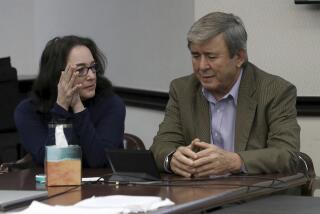A Family Affair : Garvey District’s Summer Program Seeks to Involve Parents in Child’s Education
- Share via
Near tears, the woman explained in Spanish that she felt overwhelmed and frustrated as a parent of schoolchildren. Her husband, she said, shirks his responsibility as a father. And, she told the dozen parents gathered in a circle with her, he drinks too much.
Nodding in sympathy, the discussion leader, Marcel Soriano, responded to her in Spanish. The most important thing, he said, is to develop self-esteem. Only then, he said, can you adequately help your children and husband.
Soriano is a psychologist and the director of pupil personnel services of the Garvey School District, which serves 7,400 kindergarten to eighth-grade students in Monterey Park, Rosemead and San Gabriel. The interchange came at Rosemead’s Bitely School during a two-week summer program designed to foster parental involvement. The program, which ended Friday, offered parents guidance in how to work with their children. There were activities for the children, too. More than 60 families participated this year.
On this day, the subject was gangs. But the topic touched off a discussion of broader issues of family life and education. And that, says Raquel Gutierrez, is one goal of the program.
“This is an attempt to involve parents in a different way in the school system,” said Gutierrez, director of the district’s Office of Community Services. “The parent is the child’s first teacher. Involved parents means children won’t drop out.”
Furthermore, Soriano said, “if we develop a good partnership with parents, then that will translate into a good quality of instruction in the classroom.”
The program began in 1987 and has attracted queries from 30 other school districts. “With more and more single-parent families, more dysfunctional families,” Gutierrez said, “there is a real need for this.”
One part of the program allows parents to participate in discussions on topics such as child development, drug abuse and absenteeism. “Our parents need support, even if it’s minimal and for just two weeks,” Gutierrez said. “There’s a lot of risk, if you let parents in like this. Because then you have to listen to them.”
School board member Antoinette Fabela agrees that the risk is worth taking. “The whole family benefits, and it’s important because it makes them knowledgeable about the school system,” she said.
Addresses Specific Problems
And, Gutierrez said, it addresses specific problems in the district with its rapidly changing ethnic, social and economic makeup. Five years ago, she said, 5% of Garvey students came from Asian families; now it’s 39%. An additional 54% are from Latino families.
Due to this diversity, the district must respond to cultural differences among parents, many of whom were educated in Asia and Latin America, where the educational approach is not as egalitarian as in America, Gutierrez said.
Latino and Asian parents, she said, often are reluctant to become involved in the schools because they don’t see that as their role. A survey conducted by the district two years ago, she said, showed that parents newly arrived from Asia, where parent volunteerism is uncommon, find volunteering in the schools a foreign concept.
Beyond that, said An Tieu, “they don’t know about the district and the school board.” Tieu, an ethnic Chinese originally from Vietnam, is a community involvement coordinator in the district. In their home countries, he said, the foreign-born parents wouldn’t have any influence on the operation of schools. “Parents don’t realize they have the power to change and influence everything here.”
Torn Between Cultures
Cultural differences, he said, make it even more mandatory that parents become involved. “Kids end up torn between the two cultures, and the parents don’t realize it until it’s too late,” Tieu said.
Even though the district has translators, Gutierrez said, some parents are uncomfortable because they think language barriers restrict their participation in school events.
Wai-Kam Chan, one of the few Chinese-American parents participating in the summer program, said through a translator: “This is helping me a lot in understanding about the American school system.”
Reading from notes she had taken in Chinese during the sessions, she said the classes on child development helped her understand the pitfalls that can occur if she tries to compare her sons’ behavior or development. Meanwhile, her boys, Elisha, 10, and Daniel, 9, talked about pictures they had drawn and stories they had read that morning.
Like many other husbands, Chan’s could not attend because he was working--as an auditor for Bank of America. School officials said they hope to get more families to participate by holding night sessions.
Lunch-Hour Session
One father, George Ramirez, used his lunch hour to attend part of the sessions. “My boy is in the school system and I need to know what’s going on and what they offer,” he said.
After the talk about gangs, Ramirez sat at a table with his 6-year-old son, Michael, and his wife, Delia. With a pencil, Michael traced around his father’s outstretched hand on a piece of construction paper entitled: “My Family Tree.”
Throughout the room, other parents and their children were doing the same, using the outlined hands as if they were tree branches and listing the names of parents, brothers, sisters, grandparents, aunts and uncles, and dogs and cats. “As far as I’m concerned this is gang prevention,” Ramirez said. “It starts now.”
More to Read
Sign up for Essential California
The most important California stories and recommendations in your inbox every morning.
You may occasionally receive promotional content from the Los Angeles Times.













